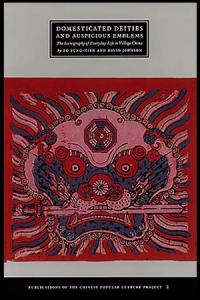Domesticated Deities and Auspicious Emblems
Domesticated Deities and Auspicious Emblems
Po Sung-nien, David Johnson
This volume studies the popular values and beliefs of ordinary people in China through the colorful representational imagery of gods and demigods, heroes and heroines, plump babies and bearded sages, and auspicious symbols depicted on woodblock prints and papercuts. Collected by Po Sung-nien over the last forty years, these examples of folk art are a valuable source for the reconstruction of popular mentalities in premodern China.
As a nonprofit academic press, we need your support to publish our books. Your gift can help us make more of our titles available as e-books. DONATE NOW
Title information
This is the exhibition catalog of a show held at the Graduate Theological Union in Berkeley in 1991 as the culmination of the Chinese Popular Culture Project. This volume studies the popular values and beliefs of ordinary people in China through the colorful representational imagery of gods and demigods, heroes and heroines, plump babies and bearded sages, and auspicious symbols depicted on woodblock prints and papercuts. Collected by Po Sung-nien over the last forty years, these examples of folk art are a valuable source for the reconstruction of popular mentalities in premodern China. This books serves as a valuable primer of Chinese popular iconography.
Po Sung-nien
Po Sung-nien (Bo Songnian 薄松年) is a former graduate and current member of the faculty at the Central Academy of Fine Arts, Beijing. He was the Chinese Popular Culture Project's Senior Residential Fellow in 1990-1991, when he curated the exhibition Domesticated Deities and Auspicious Emblems from his personal collection.He is the author of several Chinese-language books of the history of painting in China and the history of New Year's prints.
David Johnson
David G. Johnson is professor emeritus of history at the University of California, Berkeley. His research interests include premodern China and traditional Chinese popular culture. He is the co-author of Domesticated Deities and Auspicious Emblems (IEAS, 1992) and the author of Spectacle and Sacrifice: The Ritual Foundations of Village Life in North China (Harvard University Press, 2010).
A.B. at Harvard College; Ph.D. at the University of California, Berkeley
Domesticated Deities and Auspicious Emblems: An Iconography of Everyday Life in Village China (CPCP 2)
Preface—7
Introduction—9
Explanatory Note—19
Iconic Prints: The Gods of the Chinese Peasant Family
The Stove God—23
The Gods of Wealth—60
Other Gods—66
Pantheons and Ancestors—84
Buddhist Deities—96
Mimetic Prints and Papercuts
Door Gods and Door Prints—105
Chung K'uei—136
Auspicious Prints—148
Instructive Prints—162
Opera Prints—171
The Mouse's Wedding—181
Papercuts—191
Select Bibliography—205
Glossary—206
|
JOURNAL REVIEWS |
|
"In this book, [Po Sung-nien] surveys the history of the New Year print from its earliest antecedents (such as paintings of door gods on the gates of graves), through the traditional print itself until the modern communist propaganda poster. He deals mainly with the New Year print as an independent artistic genre, devoting the most attention to the handicraft dimension of the prints." ~B.J. Ter Haar, Leiden University, in T'oung Pao, Second Series, Vol. 80, Fasc. 4/5 (1994): 433-438 (http://www.jstor.org/stable/4528648) |
|
"This is a lovely and instructive volume. I wish only that it did not mark one of the last activities of a fine project." ~Stephan Feuchtwang, City University, in Asian Folklore Studies 53. no. 1 (1994): 180-182 (http://www.jstor.org/stable/1178569) |
|
"Amply illustrated and annotated, Po Sung-nien and David Johnson's Domesticated Deities and Auspicious Emblems is an important study of popular woodblock prints (especially New Year pictures) and papercuts used by ordinary people for religious blessings as well as home decoration. The authors contend that prints, which are usually meant to serve a practical purpose (e.g., attracting good fortune), are windows to people's culture in premodern China, reflecting their lives, attitudes, and aesthetic tastes....The book is a wonderful resource for the student of Chinese cultural history, for it provides a close reading of a wealth of familiar everyday life symbols....The authors also give us a good sense of the spread of woodblock prints in China by pointing out their provenances and by naming their printmaking shops." ~Chang-tai Hung, Carleton College, in The Journal of Asian Studies 52, no. 4 (Nov. 1993): 987-989 (http://www.jstor.org/stable/2059366) |

